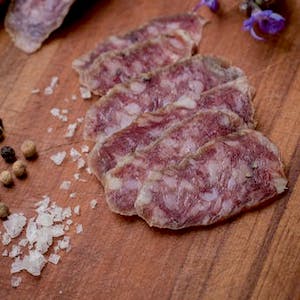Evaluation of vacuum packaging for extending the shelf life of Sardinian fermented sausage

Accepted: 24 December 2022
HTML: 6
All claims expressed in this article are solely those of the authors and do not necessarily represent those of their affiliated organizations, or those of the publisher, the editors and the reviewers. Any product that may be evaluated in this article or claim that may be made by its manufacturer is not guaranteed or endorsed by the publisher.
Authors
Salsiccia sarda or Sardinian fermented sausage is a traditional dry-fermented sausage included in the list of traditional food products of Sardinia (Italy). At the request of some producing plants, the possibility of extending the shelf life of the vacuum-packed product up to 120 days was evaluated. Manufacturing of 90 samples, representing 3 different batches of Sardinian fermented sausage was carried out in two producing plants (A and B). In the packaged product and subsequently every 30 days for four months (T0, T30, T60, T120), the following analyses were conducted on all samples: physicochemical characteristics, total aerobic mesophilic count, Enterobacteriaceae count, detection of Listeria monocytogenes, Salmonella spp., mesophilic lactic acid bacteria, and coagulase-positive Staphylococci. Moreover, surfaces in contact and surfaces not in contact with food were sampled in both producing plants. Sensory profile analysis was also performed for every analysis time. At the end of the extended shelf life, pH values were equal to 5.90±0.11 (producing plant A) and 5.61±0.29 (producing plant B). Water activity mean values at T120 were 0.894±0.02 (producing plant A) and 0.875±0.01 (producing plant B). L. monocytogenes was detected in 73.3% (33/45) of the samples from producing plant A, with mean levels of 1.12±0.76 log10 CFU/g. In producing plant B, L. monocytogenes was never detected. Enterobacteriaceae were detected in 91.1% (41/45) of samples in producing plant A with mean values of 3.15±1.21 log10 CFU/g, and in 35.5% (16/45) samples in producing plant B samples with mean values of 0.72±0.86 log10 CFU/g. Salmonella and Staphylococcus aureus were never detected. Regarding environmental samples, the sites that were most contaminated by L. monocytogenes were the bagging table (contact surface) and processing room floor drains (non-contact surface) with a prevalence of 50% each (8/16 positive samples for both sampling sites). Sensory analysis results showed that at T30 the overall sensory quality was at its highest; moreover, the visual-tactile aspect, the olfactory characteristics, the gustatory aspects, and the texture showed significant differences in samples throughout the shelf life, with a decreased intensity at 120 days of storage. Overall, the quality and sensory acceptance of the vacuum-packed Sardinian fermented sausage were not affected until 120 days of shelf-life. However, the possible contamination by L. monocytogenes calls attention to the hygienic management of the entire technological process. The environmental sampling was confirmed as a useful verification tool during control.
How to Cite

This work is licensed under a Creative Commons Attribution-NonCommercial 4.0 International License.
PAGEPress has chosen to apply the Creative Commons Attribution NonCommercial 4.0 International License (CC BY-NC 4.0) to all manuscripts to be published.

 https://doi.org/10.4081/ijfs.2023.10819
https://doi.org/10.4081/ijfs.2023.10819



